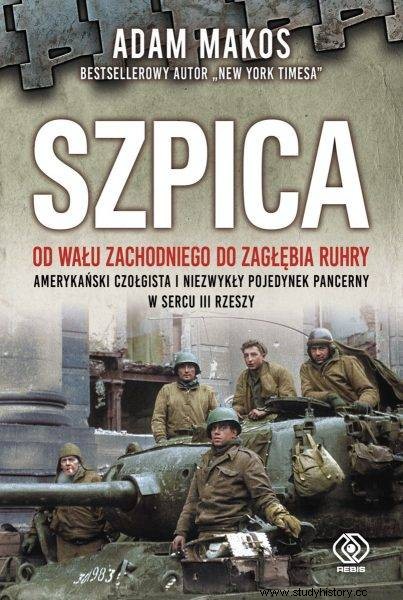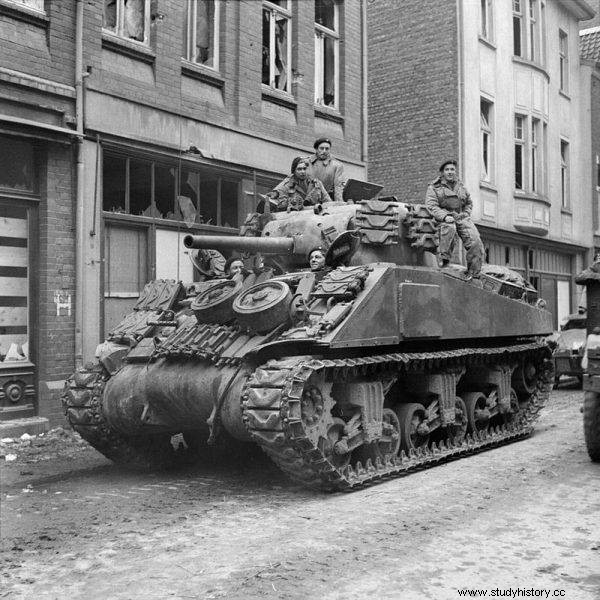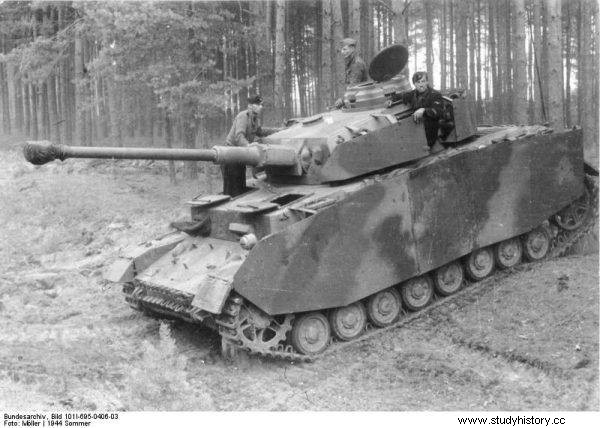Clarence Smoyer, a tanker of the US 3rd Spearhead Armored Division, was a quiet boy from Pennsylvania. Since arriving in Europe in 1944, his Sherman's crew have fought hard on the West Wall and the Ardennes, watching the Americans die in an unequal encounter with German tanks.
September 2, 1944. Occupied Belgium. (…) As long as the last shades of colors were visible in the sky, the Sherman crews quietly and efficiently replenished fuel and ammunition in their tired vehicles. Corporal Clarence Smoyer, crouching behind the turret of the first tank from the left, carefully handed the 75mm rounds straight into the hands of the waiting loader below. It was a delicate job - even the tiniest clash of metal on metal could reveal their location to the enemy.
Behind enemy lines
(…) The entire platoon was standing here. To the right of Clarence there were four more gray-olive tanks, arranged in a crescent about twenty meters apart. Farther north, out of their field of view, was Mons.... On the left, parallel to the tanks, there was a dirt road leading through the now darkening fields to a wooded ridge where the setting sun was just hiding behind the trees.
There were Germans out there, but how many exactly were there and when they were supposed to appear, none of the Americans knew. Almost three months had passed since the Allied landing in Normandy, and now Clarence and the rest of the 3rd Panzer Division were behind enemy lines.
The barrels of all platoon guns were pointed west. The division, with a full-time capacity of 390 machines, threw all its serviceable tanks between the enemy and Mons, blocking every intersection it could reach. Their survival that night was going to depend on teamwork.
"The Szpica Division"
Company HQ gave Clarence's Second Platoon a simple but important mission:to guard this path and not let anyone pass by. (...) That night no one was allowed to leave the tank; even following the need would be too risky. The bullet shells were to be used for this purpose .
A wider space opened up under Clarence's feet. The entire interior of the tank was painted with enamel and lit by three lamps. At the front, the driver and the front gunner / driver assistant slumped into the seat backs to get some sleep after the day's driving. To Clarence's left, on the other side of the cannon latch, the loader spread a sleeping bag on the turret floor. The tank smelled of fuel, gunpowder and men's cloakroom (…).

The text is an excerpt from the book by Adam Makos' Szpica. From the West Wall to the Ruhr. An American tanker and an extraordinary armored duel ", which has just been released by the Rebis publishing house. Buy now
Ever since they landed on the mainland three weeks after "D" Day, this M4A1 Sherman of "Easy" Company of the 32nd Panzer Regiment of the 3rd Panzer Division - one of America's two heavy armored divisions - has been their home.The dream would come quickly that evening. The men were exhausted. The Third Panzer was advancing at the head of the US 1st Army for eighteen days, leading two other divisions to the breach in the German front and racing through northern France. Paris was liberated and the Germans were returning the same route they had taken in 1940.
At that time, the Third Panzer was nicknamed the "Spearhead Division", meaning the "Spearhead Division".
Ambush
And then new orders came. The guys from the reconnaissance encountered German units of the 5th Panzer Army and the 15th Army retreating from northern France to Belgium, intending to cross numerous crossings around Mons. So the American 3rd Panzer Division veered sharply and headed north, covering 171 kilometers in two days, arriving just in time to ambush the enemy (...).
Halfway up Clarence's watch, the surrounding darkness came alive with a mechanical grunt. The moon was hidden behind the clouds, so the American could see nothing, but he could hear the convoy of vehicles moving along the tree-covered ridge. Forward and stop. Forward and stop.
There was only a steady hum from the loudspeaker on the wall of the tower. No light flares brightened the sky. According to later estimates of the Third Panzer, about 30,000 enemy soldiers marched there mainly from the German land forces, but members of the air force and the navy could also be found.
On the American side, however, there was no order to attack or pursue the enemy. This was because the battered remnants of the enemy's army were burning valuable fuel while looking for a safe route between roadblocks, and the Spitz was deliberately letting them wander around.
Don't let anyone pass
The adversary was desperately trying to reach the safe haven behind the West Wall, also known as the Siegfried Line, with a fortification of more than 18,000 defenses lining the border of Germany.
If those 30,000 soldiers were entrenched behind the West Wall, they could block the Americans' way into the Third Reich, thus prolonging the war . They should have been kept here in Mons, and Szpica had a plan but it was possible to wait until dawn with its implementation.
About two in the morning, the crunch of tank caterpillars could be distinguished against the distant rumble. Clarence tracked the source of the noise:vehicles were driving on the road ahead. He knew the orders - not to let anyone pass - but he had doubts (…).

Gasoline-powered Shermans caught fire easily, and the crews named them "Ronson" (for a brand of lighters)
One by one, three tanks crunched past the Shermans hidden in the darkness and continued on. Clarence started breathing again. And then one of the tanks slowed down. He began to scrape, as if his tracks lacked lubrication. The noise was unmistakable with anything else . Only all-metal tracks sound like that, and the Sherman had tracks with rubber boots. They were German tanks.
"Pork chop with bone"
Clarence put on a tank helmet and tightened the chin strap. (...) he mouthed:"German tank". The loader woke immediately. In his hatch, Paul tapped Clarence on his right shoulder, which meant he was to turn the tower to the right (...).
Once the gun was in position, aiming to the right, Paul slapped Clarence to stop the turret rotating. Clarence pressed his eyes to the periscope. Everything below the horizon was pitch black. Clarence announced to the commander that he could see nothing and suggested calling the mechanized infantry with bazookas to destroy the German tank.

The text is an excerpt from the book by Adam Makos' Szpica. From the West Wall to the Ruhr. An American tanker and an extraordinary armored duel ", which has just been released by the Rebis publishing house. Buy now
But Paul wasn't about to risk some shaky soldier wrecking the wrong tank. He grabbed a handheld microphone - called a "bone-in pork chop" because of its shape - and tuned the radio to the platoon frequency, alerting the other crews to what they probably already knew:that there was an enemy tank inside their crescent moon.(...) The German tank crew has probably already realized what a fatal mistake they made. (...) suddenly they turned off the engine. The hot bike hissed and then fell silent (…).
"The pride of the Wehrmacht"
When confronted with a German tank, they needed every asset, especially if they faced a panther, a tank from nightmares. Some American soldiers called him "the pride of the Wehrmacht." There were rumors that a panther could shoot one sherman right through and hit another with the same bullet. Its frontal armor was supposed to be impenetrable.
In July 1944 the US Army set up a few captured panthers on some field in Normandy and pounded them with the same 75mm cannon with which the Clarence Sherman was armed. The German tank proved vulnerable to hits from the sides and from the sides. from the rear, but not from the front. Not a single bullet penetrated the armor the frontal panther, no matter how far it was fired.
Clarence glanced at the fluorescent hands of his watch, knowing the Germans were probably doing the same. The countdown has begun. Someone will die here (…).
Task completed
Clarence glanced through his periscope. To the east, a faint shade of purple colored the horizon. He sat with his eye glued to the sight eyepiece until a massive shape appeared less than fifty yards away. - I can see him - he whispered (...). Clarence turned a dial for precise aim. Paul was urging him on. Now that they could see the enemy, the enemy could see them.
Clarence positioned the eyepiece crosshair so that its strands intersect on the "boulder" rising on the "hill" in front of them, then reported readiness to fire. His boot hung over the cannon trigger by a button on the footrest.
- Fire Paul snapped. Clarence's foot dropped heavily. A Sherman's barrel flashed powerfully outside, illuminating both tanks for a moment - the American in gray-olive, the German painted in sand-yellow - facing the same direction. A beam of sparks burst from the darkness, and a thunder rumbled over the countryside, reminiscent of a hammer hitting an anvil (...). Paul radioed the platoon:job done.

PzKpfw IV Ausf. H was the most popular of the PzKpfw IV
modelsThrough his periscope, he watched the dawn rising under the vault of dark clouds, in which the angular armor and the barrel of the Panzerkampfwagen IV tank were over three and a half meters long. This model - called the Mark IV by the Americans - was already old when it entered service in 1938. With time, it became the most widespread type of German tank, and it was only in August 1944 that panthers began to take over the lead in this field.
But although the PzKpfw IV was no longer the mainstay of the German armored forces, it was still a lethal weapon. Its 75mm gun had 25 percent more penetration power than the one mounted in Clarence's Sherman.
Source:
The text is an excerpt from the book by Adam Makos' Szpica. From the West Wall to the Ruhr. An American tanker and an extraordinary armored duel ", which has just been released by the Rebis publishing house.
